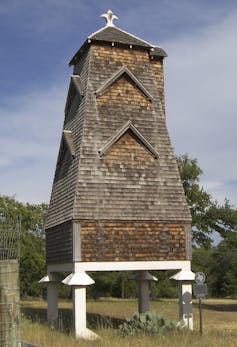How did early humans first learn to build? It’s quite possible that it was by observing animals that had already mastered the art. Indeed, when you look at the animal world many birds, insects and mammals are excellent architects and builders.
Beavers are quite literally landscape engineers – they’re being reintroduced in the UK to help fight against the increased incidence and severity of flooding caused by climate change.
Social insects like bees, wasps, ants and termites construct what many have described as the animal equivalents of human cities.
Spiders and silkworms have long been regarded as expert builders in the weaving of their silk webs. While other creatures like foxes, moles and badgers build by excavating the ground.
Then there are the animals that carry their homes on their backs – the shells of snails and turtles, for example, are both extensions of and protection for their vulnerable soft bodies.
Beyond human
We might admire and even imitate animal architecture, but when it comes to human-designed buildings, we are usually extremely selective about what kinds of creatures we allow in.
In general, animals are only ever designed for when they are of use to humans – whether as livestock, domestic pets, spectacles to consume in zoos and aquariums, or objects of scientific manipulation in laboratories.
If animals can’t be put to use, they’re usually ignored. And if those animals take it upon themselves to inhabit buildings, they’re invariably regarded as pests and dealt with accordingly.
In my new book, Animal Architecture: Beasts, Buildings and Us, I look at why we should build for animals as well as people. Indeed, wildlife is all around us and is already living in or around most of our homes, anyway.
Examples in the book include spiders spinning their webs in the dark corners of rooms. Swallows finding ideal purchase on brick walls for their saliva and mud-based nest cups. Rats making their homes in the subterranean spaces of the city. And cats and dogs appropriating our furniture and fittings as their own places of rest.
There’s hardly any part of the human-built environment that can’t be inhabited or changed by insects, animals and birds. It’s easy enough to understand how this works in relation to animals that are classed as pets. It’s generally taken for granted that pet owners know how to care for their animals. But it’s much harder to care for animals that are mostly regarded as unwelcome intruders into buildings.
Animal estates
A powerful example of the potential breadth of such interspecies awareness is artist Fritz Haeg’s Animal Estates project, which ran from 2008 until 2013. In nine different cities, Haeg organised events to encourage participation in creating structures that would be attractive to a variety of native species, including bats, birds and insects.
As well as building structures for animals to inhabit, the project also hosted events designed to stimulate interest and knowledge about native animals (and, in many cases, to encourage urban dwellers to make structures themselves). This holistic approach to ecological design aimed to foster more care for animals in cities – animals that would probably otherwise go unnoticed.
Other wildlife-inspired architectural projects include the non-profit organisation The Expanded Environment, which provides helpful online resources on how to care for a much wider range of animals in relation to architecture – most notably in their collaborative design proposals and annual competitions for novel types of animal design.
The material on their website expands ideas about what might be considered appropriate animals for designers to work with as “clients”. Insects appear alongside dogs and cats, birds with lizards and bats with oysters.
Housing the non-human
A contemporary reconstruction of Charles A. Campbell’s Municipal Bat House (1914), near Comfort, Texas, 2009. Wikimedia Commons, Larry D. Moore/cc-by-sa 4.0 International, CC BY-SA
Ultimately thinking beyond just people is important because all lifeforms create their own environments – and what humans generally call “the environment” is in reality the sum of these creations. Why then does the idea that humans live outside of the environment persist so strongly?
Perhaps, as any therapist will likely tell you, losing a fantasy is always much harder than losing a reality. Yet, as is all too obvious, the persistence of the fantasy of human exceptionalism is now endangering all life on the planet.
It is humans, and humans alone, who dominate every corner of the environment, while at the same time asserting they are actually removed from that environment. If my book has one core aim, it is to encourage readers to think beyond humans in the way we imagine, design and live in our buildings and cities.



 ETH Whales on Rampage: BitMine Snags 138K ETH as $3,000 Holds Firm – Bulls Gear Up for $4,000 Moonshot
ETH Whales on Rampage: BitMine Snags 138K ETH as $3,000 Holds Firm – Bulls Gear Up for $4,000 Moonshot  Holiday Economic Questions: What Bank of America Says You Should Expect
Holiday Economic Questions: What Bank of America Says You Should Expect  Morgan Stanley Downgrades Tesla as AI Growth Expectations Rise
Morgan Stanley Downgrades Tesla as AI Growth Expectations Rise  Austria’s AA Credit Rating Affirmed as Fitch Highlights Stable Outlook
Austria’s AA Credit Rating Affirmed as Fitch Highlights Stable Outlook  Asia’s IPO Market Set for Strong Growth as China and India Drive Investor Diversification
Asia’s IPO Market Set for Strong Growth as China and India Drive Investor Diversification  Bitcoin Reserves Hit 5-Year Low as $2.15B Exits Exchanges – Bulls Quietly Loading the Spring Below $100K
Bitcoin Reserves Hit 5-Year Low as $2.15B Exits Exchanges – Bulls Quietly Loading the Spring Below $100K 
































